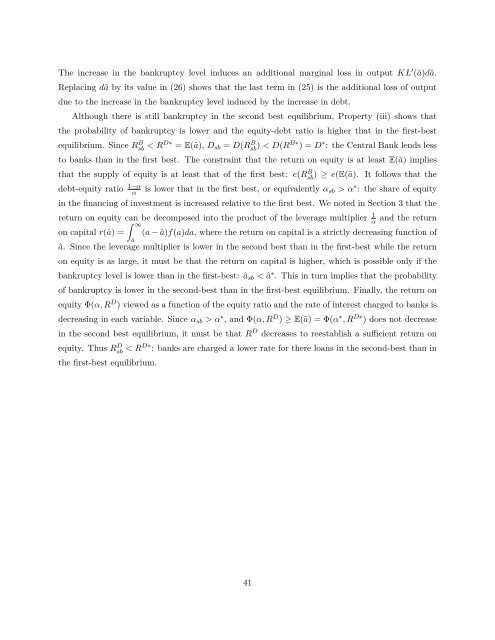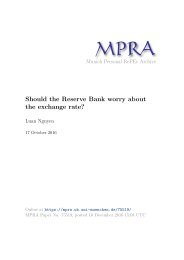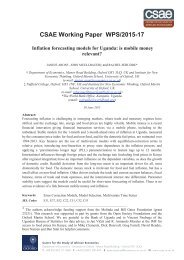debtequity
n?u=RePEc:red:sed016:1511&r=cba
n?u=RePEc:red:sed016:1511&r=cba
Create successful ePaper yourself
Turn your PDF publications into a flip-book with our unique Google optimized e-Paper software.
The increase in the bankruptcy level induces an additional marginal loss in output KL ′ (â)dâ.<br />
Replacing dâ by its value in (26) shows that the last term in (25) is the additional loss of output<br />
due to the increase in the bankruptcy level induced by the increase in debt.<br />
Although there is still bankruptcy in the second best equilibrium, Property (iii) shows that<br />
the probability of bankruptcy is lower and the equity-debt ratio is higher that in the first-best<br />
equilibrium. Since R B sb < RD∗ = E(ã), D sb = D(R B sb ) < D(RB∗ ) = D ∗ : the Central Bank lends less<br />
to banks than in the first best. The constraint that the return on equity is at least E(ã) implies<br />
that the supply of equity is at least that of the first best: e(Rsb B ) ≥ e(E(ã). It follows that the<br />
debt-equity ratio 1−α<br />
α<br />
is lower that in the first best, or equivalently α sb > α ∗ : the share of equity<br />
in the financing of investment is increased relative to the first best. We noted in Section 3 that the<br />
return on equity can ∫ be decomposed into the product of the leverage multiplier 1 α<br />
and the return<br />
∞<br />
on capital r(â) = (a − â)f(a)da, where the return on capital is a strictly decreasing function of<br />
â<br />
â. Since the leverage multiplier is lower in the second best than in the first-best while the return<br />
on equity is as large, it must be that the return on capital is higher, which is possible only if the<br />
bankruptcy level is lower than in the first-best: â sb < â ∗ . This in turn implies that the probability<br />
of bankruptcy is lower in the second-best than in the first-best equilibrium. Finally, the return on<br />
equity Φ(α, R D ) viewed as a function of the equity ratio and the rate of interest charged to banks is<br />
decreasing in each variable. Since α sb > α ∗ , and Φ(α, R D ) ≥ E(ã) = Φ(α ∗ , R D∗ ) does not decrease<br />
in the second best equilibrium, it must be that R D decreases to reestablish a sufficient return on<br />
equity. Thus R D sb < RD∗ : banks are charged a lower rate for there loans in the second-best than in<br />
the first-best equilibrium.<br />
41





